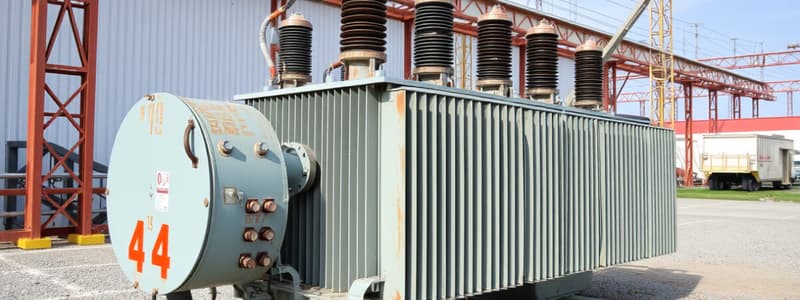Podcast
Questions and Answers
What are FOUR desirable characteristics of transformer cooling mediums? (Select one or more)
What are FOUR desirable characteristics of transformer cooling mediums? (Select one or more)
- Low dielectric strength to increase the insulation distances from the walls of the tank
- Low resistance to emulsion in order to hold moisture in suspension in the fluid
- High resistance to emulsion in order to prevent the holding of moisture in suspension in the fluid (correct)
- High dielectric strength to reduce the insulation distances from the walls of the tank (correct)
- High viscosity to enable slower circulation of the fluid and dissipation of heat
- Low viscosity to enable rapid circulation of the fluid and dissipation of heat (correct)
- Does not form sludge under normal operating conditions (correct)
- Forms sludge under normal operating conditions for additional cooling properties
Match the correct acronym for each cooling method description:
Match the correct acronym for each cooling method description:
A method of cooling a transformer where natural air circulation is used = AN A transformer with a high current application that uses a heat exchanger to transfer heat from transformer oil to cooling water = ONWF A transformer that uses fans to increase the effectiveness of natural air to cool the transformer = ONAF
As well as cooling, what other role does transformer oil play?
As well as cooling, what other role does transformer oil play?
- Power factor correction
- Lubricates the windings
- Prevents transformer lamination mains hum
- Forms part of the transformer insulation system (correct)
Two power losses in a transformer are iron losses and excitation losses.
Two power losses in a transformer are iron losses and excitation losses.
In identifying iron losses and copper losses, which two tests are required?
In identifying iron losses and copper losses, which two tests are required?
When the efficiency of a transformer (at a specific power factor) is at maximum, what are copper losses?
When the efficiency of a transformer (at a specific power factor) is at maximum, what are copper losses?
To calculate the efficiency of a transformer, which of the following formulas would be most useful?
To calculate the efficiency of a transformer, which of the following formulas would be most useful?
Calculate the efficiency of the transformer when a 10KVA transformer has total losses of 450 watts:
Calculate the efficiency of the transformer when a 10KVA transformer has total losses of 450 watts:
What is the increase of the kVA rating of the transformer when auxiliary equipment such as pumps or fans are used to cool the transformer?
What is the increase of the kVA rating of the transformer when auxiliary equipment such as pumps or fans are used to cool the transformer?
Flashcards are hidden until you start studying
Study Notes
Transformer Cooling Characteristics
- Desirable cooling mediums should have high resistance to emulsion, preventing moisture retention in the fluid.
- High viscosity is important for slower circulation of fluid, aiding in heat dissipation.
- Low viscosity allows for rapid fluid circulation, enhancing heat dissipation efficiency.
- Cooling mediums must not form sludge under normal operating conditions, maintaining fluid quality.
Transformer Cooling Methods
- Natural air circulation is used in Air Natural (AN) cooling method.
- Oil Natural Water Forced (ONWF) involves using a heat exchanger to transfer heat from the transformer oil to cooling water.
- Oil Natural Air Forced (ONAFA) employs fans to enhance the cooling effect of natural air circulation.
Functions of Transformer Oil
- Besides cooling, transformer oil plays a critical role in insulation within the transformer, ensuring safety and efficiency.
Transformer Power Losses
- Iron losses are associated with magnetic properties, while copper losses relate to electrical conduction.
- Two main power losses in transformers are iron losses (not excitation losses, despite some confusion).
- Testing methods: use open circuit tests to identify iron losses and short circuit tests for copper losses.
Efficiency of Transformers
- At maximum efficiency and in specific power factors, copper losses equal iron losses.
- Transformer efficiency can be calculated using the formula:
- n% = ((Pin - Losses) / Pin) x 100
- Example: A 10 KVA transformer with total losses of 450 watts has an efficiency of approximately 95.7%.
Impact of Auxiliary Equipment
- The kVA rating of a transformer can increase up to one third with the use of auxiliary equipment like pumps or fans for cooling.
Studying That Suits You
Use AI to generate personalized quizzes and flashcards to suit your learning preferences.



